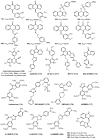An overview of tubulin inhibitors that interact with the colchicine binding site
- PMID: 22814904
- PMCID: PMC3667160
- DOI: 10.1007/s11095-012-0828-z
An overview of tubulin inhibitors that interact with the colchicine binding site
Abstract
Tubulin dynamics is a promising target for new chemotherapeutic agents. The colchicine binding site is one of the most important pockets for potential tubulin polymerization destabilizers. Colchicine binding site inhibitors (CBSI) exert their biological effects by inhibiting tubulin assembly and suppressing microtubule formation. A large number of molecules interacting with the colchicine binding site have been designed and synthesized with significant structural diversity. CBSIs have been modified as to chemical structure as well as pharmacokinetic properties, and tested in order to find a highly potent, low toxicity agent for treatment of cancers. CBSIs are believed to act by a common mechanism via binding to the colchicine site on tubulin. The present review is a synopsis of compounds that have been reported in the past decade that have provided an increase in our understanding of the actions of CBSIs.
Figures















Similar articles
-
Tubulin inhibitors targeting the colchicine binding site: a perspective of privileged structures.Future Med Chem. 2017 Oct;9(15):1765-1794. doi: 10.4155/fmc-2017-0100. Epub 2017 Sep 20. Future Med Chem. 2017. PMID: 28929799 Review.
-
Recent Advances in Heterocyclic Tubulin Inhibitors Targeting the Colchicine Binding Site.Anticancer Agents Med Chem. 2016;16(10):1325-38. doi: 10.2174/1871520616666160219161921. Anticancer Agents Med Chem. 2016. PMID: 26899186 Review.
-
An update on the recent advances and discovery of novel tubulin colchicine binding inhibitors.Future Med Chem. 2023 Jan;15(1):73-95. doi: 10.4155/fmc-2022-0212. Epub 2023 Feb 9. Future Med Chem. 2023. PMID: 36756851 Review.
-
Design, synthesis and biological evaluation of a novel tubulin inhibitor 7a3 targeting the colchicine binding site.Eur J Med Chem. 2018 Aug 5;156:162-179. doi: 10.1016/j.ejmech.2018.05.010. Epub 2018 May 10. Eur J Med Chem. 2018. PMID: 30006162
-
Design and synthesis of novel 5-(4-chlorophenyl)furan derivatives with inhibitory activity on tubulin polymerization.Future Med Chem. 2018 Aug 1;10(16):1907-1924. doi: 10.4155/fmc-2018-0036. Epub 2018 Jul 3. Future Med Chem. 2018. PMID: 29966433 Free PMC article.
Cited by
-
Panobinostat Synergistically Enhances the Cytotoxicity of Microtubule Destabilizing Drugs in Ovarian Cancer Cells.Int J Mol Sci. 2022 Oct 27;23(21):13019. doi: 10.3390/ijms232113019. Int J Mol Sci. 2022. PMID: 36361809 Free PMC article.
-
Identification of Potential Antitubulin Agents with Anticancer Assets from a Series of Imidazo[1,2-a]quinoxaline Derivatives: In Silico and In Vitro Approaches.Molecules. 2023 Jan 13;28(2):802. doi: 10.3390/molecules28020802. Molecules. 2023. PMID: 36677860 Free PMC article.
-
Structural Modification of the 3,4,5-Trimethoxyphenyl Moiety in the Tubulin Inhibitor VERU-111 Leads to Improved Antiproliferative Activities.J Med Chem. 2018 Sep 13;61(17):7877-7891. doi: 10.1021/acs.jmedchem.8b00827. Epub 2018 Aug 30. J Med Chem. 2018. PMID: 30122035 Free PMC article.
-
Molecular interactions at the colchicine binding site in tubulin: An X-ray crystallography perspective.Drug Discov Today. 2022 Mar;27(3):759-776. doi: 10.1016/j.drudis.2021.12.001. Epub 2021 Dec 8. Drug Discov Today. 2022. PMID: 34890803 Free PMC article. Review.
-
Design, Synthesis and Biological Evaluation of Novel 5H-Chromenopyridines as Potential Anti-Cancer Agents.Molecules. 2015 Sep 17;20(9):17152-65. doi: 10.3390/molecules200917152. Molecules. 2015. PMID: 26393554 Free PMC article.
References
-
- Pryor DE, O’Brate A, Bilcer G, Diaz JF, Wang Y, Kabaki M, et al. The microtubule stabilizing agent laulimalide does not bind in the taxoid site, kills cells resistant to paclitaxel and epothilones, and may not require its epoxide moiety for activity. Biochemistry. 2002;41:9109–15. - PubMed
-
- Gigant B, Wang C, Ravelli RB, Roussi F, Steinmetz MO, Curmi PA, et al. Structural basis for the regulation of tubulin by vinblastine. Nature. 2005;435:519–22. - PubMed
-
- Ravelli RB, Gigant B, Curmi PA, Jourdain I, Lachkar S, Sobel A, et al. Insight into tubulin regulation from a complex with colchicine and a stathmin-like domain. Nature. 2004;428:198–202. - PubMed
-
- Seveand P, Dumontet C. Is class III beta-tubulin a predictive factor in patients receiving tubulin-binding agents? The Lancet Oncology. 2008;9:168–75. - PubMed
Publication types
MeSH terms
Substances
Grants and funding
LinkOut - more resources
Full Text Sources
Other Literature Sources
Medical
Molecular Biology Databases
Miscellaneous

